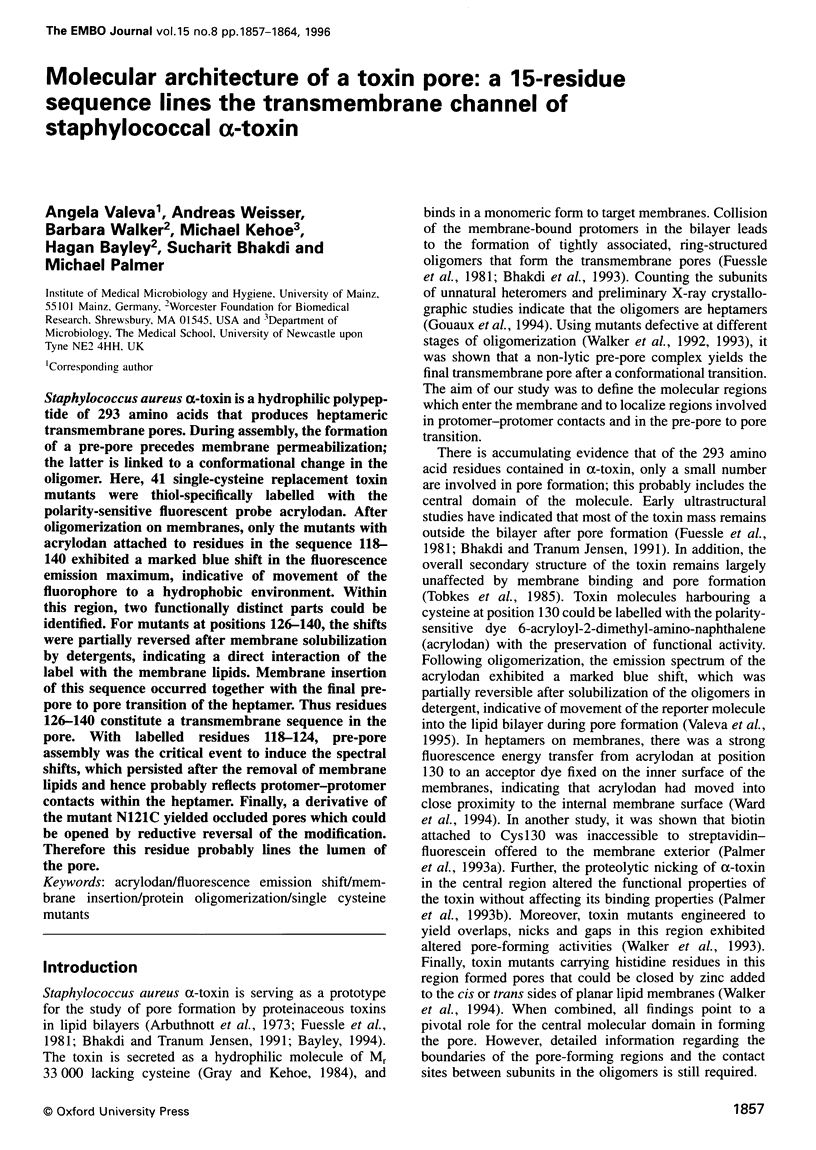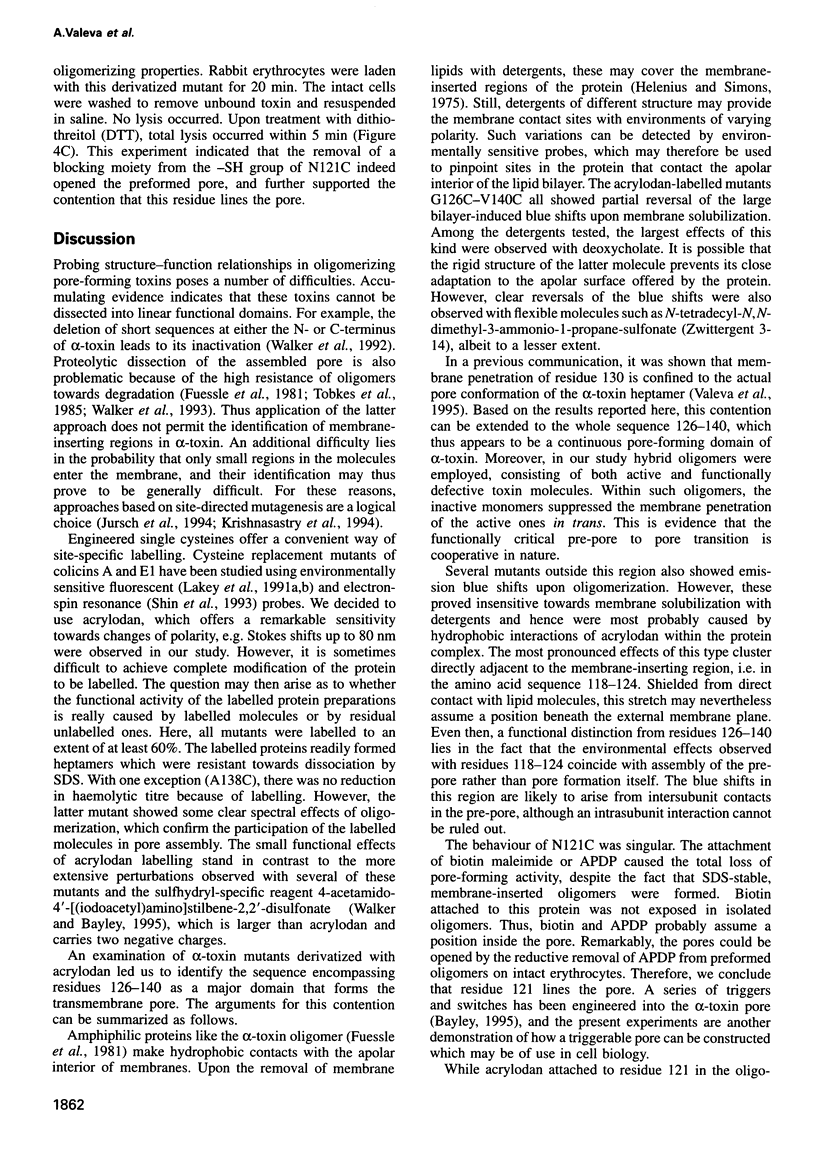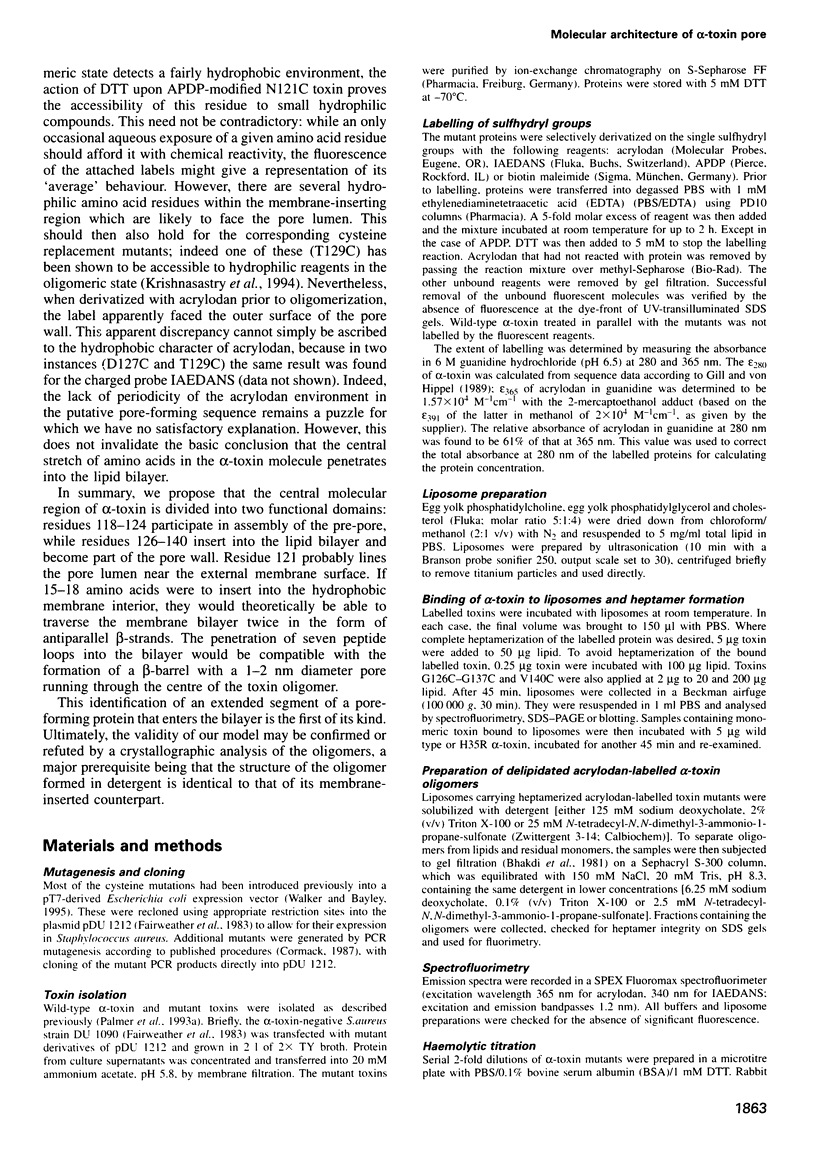Abstract
Staphylococcus aureus alpha-toxin is a hydrophilic polypeptide of 293 amino acids that produces heptameric transmembrane pores. During assembly, the formation of a pre-pore precedes membrane permeabilization; the latter is linked to a conformational change in the oligomer. Here, 41 single-cysteine replacement toxin mutants were thiol-specifically labelled with the polarity-sensitive fluorescent probe acrylodan. After oligomerization on membranes, only the mutants with acrylodan attached to residues in the sequence 118-140 exhibited a marked blue shift in the fluorescence emission maximum, indicative of movement of the fluorophore to a hydrophobic environment. Within this region, two functionally distinct parts could be identified. For mutants at positions 126-140, the shifts were partially reversed after membrane solubilization by detergents, indicating a direct interaction of the label with the membrane lipids. Membrane insertion of this sequence occurred together with the final pre-pore to pore transition of the heptamer. Thus residues 126-140 constitute a transmembrane sequence in the pore. With labelled residues 118-124, pre-pore assembly was the critical event to induce the spectral shifts, which persisted after the removal of membrane lipids and hence probably reflects protomer-protomer contacts within the heptamer. Finally, a derivative of the mutant N121C yielded occluded pores which could be opened by reductive reversal of the modification. Therefore this residue probably lines the lumen of the pore.
Full text
PDF







Images in this article
Selected References
These references are in PubMed. This may not be the complete list of references from this article.
- Arbuthnott J. P., Freer J. H., Billcliffe B. Lipid-induced polymerization of staphylococcal -toxin. J Gen Microbiol. 1973 Apr;75(2):309–319. doi: 10.1099/00221287-75-2-309. [DOI] [PubMed] [Google Scholar]
- Bayley H. Triggers and switches in a self-assembling pore-forming protein. J Cell Biochem. 1994 Oct;56(2):177–182. doi: 10.1002/jcb.240560210. [DOI] [PubMed] [Google Scholar]
- Bhakdi S., Füssle R., Tranum-Jensen J. Staphylococcal alpha-toxin: oligomerization of hydrophilic monomers to form amphiphilic hexamers induced through contact with deoxycholate detergent micelles. Proc Natl Acad Sci U S A. 1981 Sep;78(9):5475–5479. doi: 10.1073/pnas.78.9.5475. [DOI] [PMC free article] [PubMed] [Google Scholar]
- Bhakdi S., Muhly M., Füssle R. Correlation between toxin binding and hemolytic activity in membrane damage by staphylococcal alpha-toxin. Infect Immun. 1984 Nov;46(2):318–323. doi: 10.1128/iai.46.2.318-323.1984. [DOI] [PMC free article] [PubMed] [Google Scholar]
- Bhakdi S., Tranum-Jensen J. Alpha-toxin of Staphylococcus aureus. Microbiol Rev. 1991 Dec;55(4):733–751. doi: 10.1128/mr.55.4.733-751.1991. [DOI] [PMC free article] [PubMed] [Google Scholar]
- Bhakdi S., Weller U., Walev I., Martin E., Jonas D., Palmer M. A guide to the use of pore-forming toxins for controlled permeabilization of cell membranes. Med Microbiol Immunol. 1993 Sep;182(4):167–175. doi: 10.1007/BF00219946. [DOI] [PubMed] [Google Scholar]
- Fairweather N., Kennedy S., Foster T. J., Kehoe M., Dougan G. Expression of a cloned Staphylococcus aureus alpha-hemolysin determinant in Bacillus subtilis and Staphylococcus aureus. Infect Immun. 1983 Sep;41(3):1112–1117. doi: 10.1128/iai.41.3.1112-1117.1983. [DOI] [PMC free article] [PubMed] [Google Scholar]
- Füssle R., Bhakdi S., Sziegoleit A., Tranum-Jensen J., Kranz T., Wellensiek H. J. On the mechanism of membrane damage by Staphylococcus aureus alpha-toxin. J Cell Biol. 1981 Oct;91(1):83–94. doi: 10.1083/jcb.91.1.83. [DOI] [PMC free article] [PubMed] [Google Scholar]
- Gill S. C., von Hippel P. H. Calculation of protein extinction coefficients from amino acid sequence data. Anal Biochem. 1989 Nov 1;182(2):319–326. doi: 10.1016/0003-2697(89)90602-7. [DOI] [PubMed] [Google Scholar]
- Gouaux J. E., Braha O., Hobaugh M. R., Song L., Cheley S., Shustak C., Bayley H. Subunit stoichiometry of staphylococcal alpha-hemolysin in crystals and on membranes: a heptameric transmembrane pore. Proc Natl Acad Sci U S A. 1994 Dec 20;91(26):12828–12831. doi: 10.1073/pnas.91.26.12828. [DOI] [PMC free article] [PubMed] [Google Scholar]
- Gray G. S., Kehoe M. Primary sequence of the alpha-toxin gene from Staphylococcus aureus wood 46. Infect Immun. 1984 Nov;46(2):615–618. doi: 10.1128/iai.46.2.615-618.1984. [DOI] [PMC free article] [PubMed] [Google Scholar]
- Helenius A., Simons K. Solubilization of membranes by detergents. Biochim Biophys Acta. 1975 Mar 25;415(1):29–79. doi: 10.1016/0304-4157(75)90016-7. [DOI] [PubMed] [Google Scholar]
- Jursch R., Hildebrand A., Hobom G., Tranum-Jensen J., Ward R., Kehoe M., Bhakdi S. Histidine residues near the N terminus of staphylococcal alpha-toxin as reporters of regions that are critical for oligomerization and pore formation. Infect Immun. 1994 Jun;62(6):2249–2256. doi: 10.1128/iai.62.6.2249-2256.1994. [DOI] [PMC free article] [PubMed] [Google Scholar]
- Krishnasastry M., Walker B., Braha O., Bayley H. Surface labeling of key residues during assembly of the transmembrane pore formed by staphylococcal alpha-hemolysin. FEBS Lett. 1994 Dec 12;356(1):66–71. doi: 10.1016/0014-5793(94)01240-7. [DOI] [PubMed] [Google Scholar]
- Lakey J. H., Baty D., Pattus F. Fluorescence energy transfer distance measurements using site-directed single cysteine mutants. The membrane insertion of colicin A. J Mol Biol. 1991 Apr 5;218(3):639–653. doi: 10.1016/0022-2836(91)90707-d. [DOI] [PubMed] [Google Scholar]
- Palmer M., Jursch R., Weller U., Valeva A., Hilgert K., Kehoe M., Bhakdi S. Staphylococcus aureus alpha-toxin. Production of functionally intact, site-specifically modifiable protein by introduction of cysteine at positions 69, 130, and 186. J Biol Chem. 1993 Jun 5;268(16):11959–11962. [PubMed] [Google Scholar]
- Palmer M., Weller U., Messner M., Bhakdi S. Altered pore-forming properties of proteolytically nicked staphylococcal alpha-toxin. J Biol Chem. 1993 Jun 5;268(16):11963–11967. [PubMed] [Google Scholar]
- Panchal R. G., Bayley H. Interactions between residues in staphylococcal alpha-hemolysin revealed by reversion mutagenesis. J Biol Chem. 1995 Sep 29;270(39):23072–23076. doi: 10.1074/jbc.270.39.23072. [DOI] [PubMed] [Google Scholar]
- Prendergast F. G., Meyer M., Carlson G. L., Iida S., Potter J. D. Synthesis, spectral properties, and use of 6-acryloyl-2-dimethylaminonaphthalene (Acrylodan). A thiol-selective, polarity-sensitive fluorescent probe. J Biol Chem. 1983 Jun 25;258(12):7541–7544. [PubMed] [Google Scholar]
- Shin Y. K., Levinthal C., Levinthal F., Hubbell W. L. Colicin E1 binding to membranes: time-resolved studies of spin-labeled mutants. Science. 1993 Feb 12;259(5097):960–963. doi: 10.1126/science.8382373. [DOI] [PubMed] [Google Scholar]
- Tobkes N., Wallace B. A., Bayley H. Secondary structure and assembly mechanism of an oligomeric channel protein. Biochemistry. 1985 Apr 9;24(8):1915–1920. doi: 10.1021/bi00329a017. [DOI] [PubMed] [Google Scholar]
- Valeva A., Palmer M., Hilgert K., Kehoe M., Bhakdi S. Correct oligomerization is a prerequisite for insertion of the central molecular domain of staphylococcal alpha-toxin into the lipid bilayer. Biochim Biophys Acta. 1995 Jun 14;1236(2):213–218. doi: 10.1016/0005-2736(95)00060-g. [DOI] [PubMed] [Google Scholar]
- Walker B., Bayley H. Key residues for membrane binding, oligomerization, and pore forming activity of staphylococcal alpha-hemolysin identified by cysteine scanning mutagenesis and targeted chemical modification. J Biol Chem. 1995 Sep 29;270(39):23065–23071. doi: 10.1074/jbc.270.39.23065. [DOI] [PubMed] [Google Scholar]
- Walker B., Kasianowicz J., Krishnasastry M., Bayley H. A pore-forming protein with a metal-actuated switch. Protein Eng. 1994 May;7(5):655–662. doi: 10.1093/protein/7.5.655. [DOI] [PubMed] [Google Scholar]
- Walker B., Krishnasastry M., Bayley H. Functional complementation of staphylococcal alpha-hemolysin fragments. Overlaps, nicks, and gaps in the glycine-rich loop. J Biol Chem. 1993 Mar 5;268(7):5285–5292. [PubMed] [Google Scholar]
- Walker B., Krishnasastry M., Zorn L., Bayley H. Assembly of the oligomeric membrane pore formed by Staphylococcal alpha-hemolysin examined by truncation mutagenesis. J Biol Chem. 1992 Oct 25;267(30):21782–21786. [PubMed] [Google Scholar]
- Ward R. J., Palmer M., Leonard K., Bhakdi S. Identification of a putative membrane-inserted segment in the alpha-toxin of Staphylococcus aureus. Biochemistry. 1994 Jun 14;33(23):7477–7484. doi: 10.1021/bi00189a056. [DOI] [PubMed] [Google Scholar]



